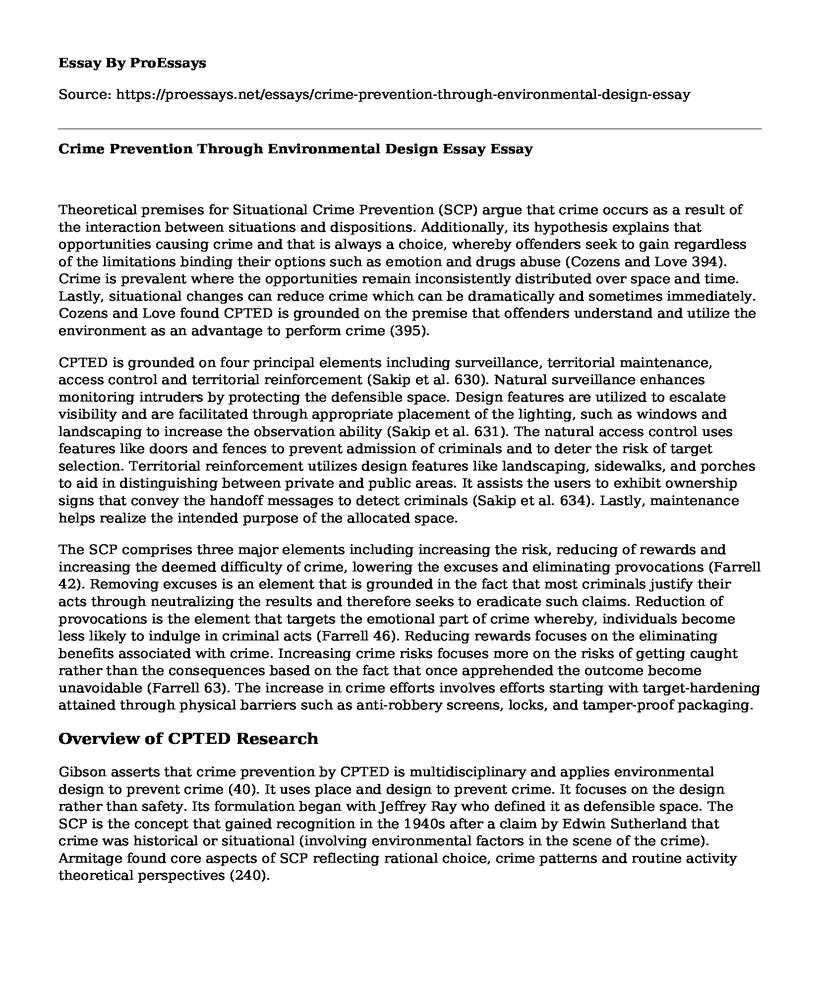Theoretical premises for Situational Crime Prevention (SCP) argue that crime occurs as a result of the interaction between situations and dispositions. Additionally, its hypothesis explains that opportunities causing crime and that is always a choice, whereby offenders seek to gain regardless of the limitations binding their options such as emotion and drugs abuse (Cozens and Love 394). Crime is prevalent where the opportunities remain inconsistently distributed over space and time. Lastly, situational changes can reduce crime which can be dramatically and sometimes immediately. Cozens and Love found CPTED is grounded on the premise that offenders understand and utilize the environment as an advantage to perform crime (395).
CPTED is grounded on four principal elements including surveillance, territorial maintenance, access control and territorial reinforcement (Sakip et al. 630). Natural surveillance enhances monitoring intruders by protecting the defensible space. Design features are utilized to escalate visibility and are facilitated through appropriate placement of the lighting, such as windows and landscaping to increase the observation ability (Sakip et al. 631). The natural access control uses features like doors and fences to prevent admission of criminals and to deter the risk of target selection. Territorial reinforcement utilizes design features like landscaping, sidewalks, and porches to aid in distinguishing between private and public areas. It assists the users to exhibit ownership signs that convey the handoff messages to detect criminals (Sakip et al. 634). Lastly, maintenance helps realize the intended purpose of the allocated space.
The SCP comprises three major elements including increasing the risk, reducing of rewards and increasing the deemed difficulty of crime, lowering the excuses and eliminating provocations (Farrell 42). Removing excuses is an element that is grounded in the fact that most criminals justify their acts through neutralizing the results and therefore seeks to eradicate such claims. Reduction of provocations is the element that targets the emotional part of crime whereby, individuals become less likely to indulge in criminal acts (Farrell 46). Reducing rewards focuses on the eliminating benefits associated with crime. Increasing crime risks focuses more on the risks of getting caught rather than the consequences based on the fact that once apprehended the outcome become unavoidable (Farrell 63). The increase in crime efforts involves efforts starting with target-hardening attained through physical barriers such as anti-robbery screens, locks, and tamper-proof packaging.
Overview of CPTED Research
Gibson asserts that crime prevention by CPTED is multidisciplinary and applies environmental design to prevent crime (40). It uses place and design to prevent crime. It focuses on the design rather than safety. Its formulation began with Jeffrey Ray who defined it as defensible space. The SCP is the concept that gained recognition in the 1940s after a claim by Edwin Sutherland that crime was historical or situational (involving environmental factors in the scene of the crime). Armitage found core aspects of SCP reflecting rational choice, crime patterns and routine activity theoretical perspectives (240).
Pros and Cons of CPTED
CPTED reduces resident victimization, crime rate and guaranteeing an escalated sense of security and quality of life by overcoming the fear of crime. Additionally, it creates heightened resident interactions and strong neighborhood bonds (Gibson 48). It also strengths the ties between city planners, private security, area builders and public law enforcement. Lastly, CPTED encourages a resident sense of territoriality and improves a feeling of capability and willingness to control their space. CPTED faces two major short-comings based on environmental factors. First CPTED is prone to ineffectiveness in low dormancy and illumination in the public areas, especially at night (Gibson 93). Additionally, extremely low-density grounds with considerably privatized areas as well as lacking the sense of the public areas do not typically facilitate natural surveillance in the public spaces.
The Pros and Cons of SCP
The SCP aims at reducing opportunities for conducting opportunistic offenses like theft and burglary, through changing immediate crime environments, escalating the risk and also decreasing the rewards. Additionally, it facilitates environmental crime prevention. Zero tolerance is required to avoid creation of more crimes through tolerating some offense. Conversely, SCP criticism emerges of unnecessary prevention of crime instead displaces it (Johnson, Guerette and Bowers 571). Such leaves left realists claiming that SCP overlooks the white-collar crimes and focuses on the petty utilitarian sorts of crime rather than finding the roots causes of crime (572).
Works Cited
Armitage, Rachel. Design, Crime and the Built Environment. In: Handbook of Crime Prevention and Community Safety. Routledge, 2017.
Cozens, Paul, and Terence Love. "A review and current status of crime prevention through environmental design (CPTED)." Journal of Planning Literature 30.4 (2015): 393-412.
Farrell, Graham. "Situational crime prevention and its discontents: Rational choice and harm reduction versus 'cultural criminology'." Social Policy & Administration 44.1 (2010): 40-66.
Gibson, Victoria. Third Generation CPTED? Rethinking the Basis for Crime Prevention Strategies. Diss. Northumbria University, 2016.
Johnson, Shane D., Rob T. Guerette, and Kate Bowers. "Crime displacement: what we know, what we don't know, and what it means for crime reduction." Journal of Experimental Criminology 10.4 (2014): 549-571.
Sakip, Siti Rasidah Md, Noraini Johari, and Mohd Najib Mohd Salleh. "The relationship between crime prevention through environmental design and fear of crime." Procedia-Social and Behavioral Sciences 68 (2012): 628-636.
Cite this page
Crime Prevention Through Environmental Design Essay. (2022, Apr 14). Retrieved from https://proessays.net/essays/crime-prevention-through-environmental-design-essay
If you are the original author of this essay and no longer wish to have it published on the ProEssays website, please click below to request its removal:
- BBC Documentary on Iran and the West Paper Example
- Research Paper on Adapting Stories to Broadway: Popularity with Audiences
- Paper Example on Shelby v Holder: US Voting Rights & the 1965 Act
- Essay Example on Ancient Greek Letter Writing: Paul's Epistles
- Unlocking Secrets: Detecting Latent Prints With Lumination and Fluids - Essay Sample
- Paper Example on Anonymous Reporting: Finding Your Voice to Stand Against Fear
- Essay Example on HIPAA Regulations: Requirements for Handling ePHI Data







